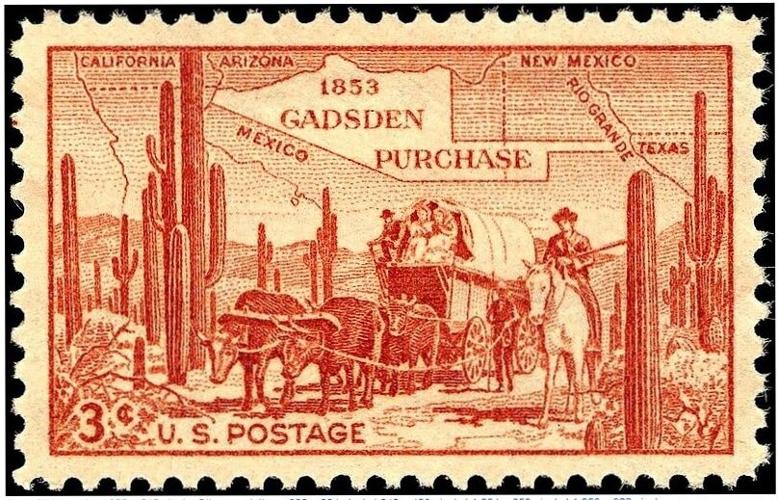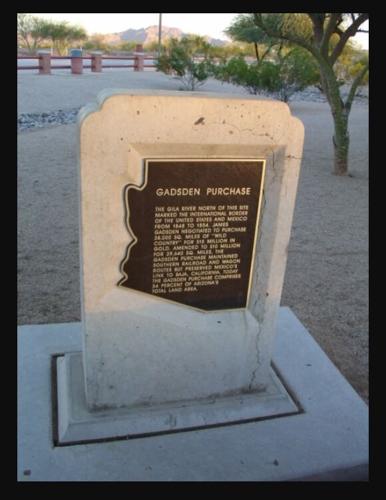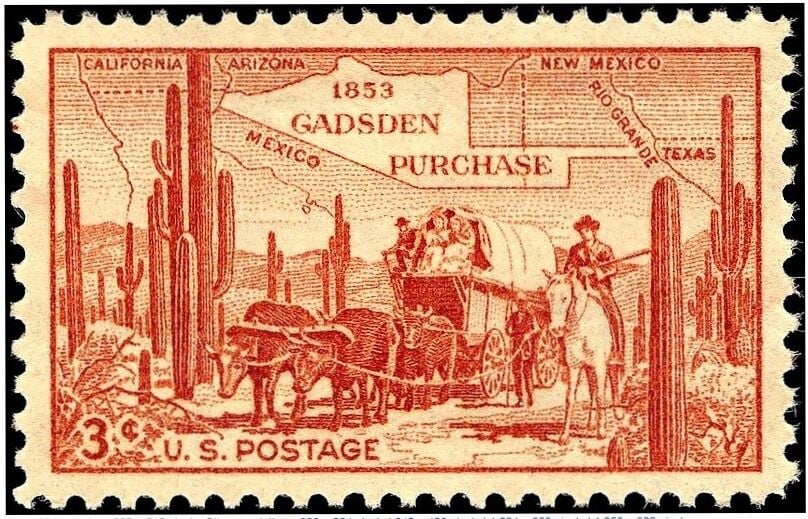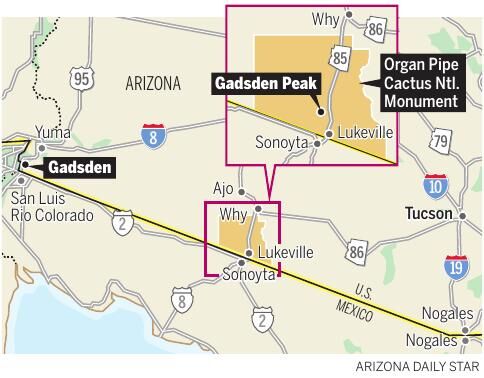James Gadsden, ambassador to Mexico, purchased the land south of the Gila River from Mexico in 1853, an area first called the Gadsden Purchase, now Southern Arizona. His name lives on today in Gadsden Peak and Gadsden, Arizona, among other places.
Here is his story:
Gadsden was born on May 15, 1788, in Charleston, South Carolina. He was the grandson of Christopher Gadsden, who was elected to the First Continental Congress, served as a brigadier general in the Continental Army during the American Revolution, and is also the namesake of the well-known Gadsden Flag, with its yellow background, coiled rattlesnake and the “Don’t Tread On Me” phrase.
Gadsden graduated from Yale College (now Yale University) in New Haven, Connecticut, in 1806, before returning home to the city of his birth where he was involved in business for a time.

Gadsden Purchase Historical Marker near Casa Grande
By the War of 1812, in which the United States fought Great Britain for the second time in less than half a century, he had been appointed as lieutenant of engineers in the U.S. Army, working on defenses of the Gulf Coast which continued after the war. At one point he became aide-de-camp to General Andrew Jackson, later president of the United States.
In 1818, he first set foot in Spanish Florida accompanying Jackson during the First Seminole War in order to help reconstruct a partially destroyed fort on the Apalachicola River. When the fort was completed, Jackson named it Fort Gadsden.
By 1820, he had earned the rank of colonel in the military and the following year was put in charge of establishing military posts in what soon became known as the Florida Territory, which had recently become a part of the country.
In 1822, he left the military but remained in the service of the U.S. government possibly as a surveyor and road builder. In 1823, he was appointed commissioner in charge of removing the Seminole tribe from the northern part of the Florida Territory to a central reservation as a result of the Treaty of Moultrie Creek.

James Gadsden
In 1824, he became a member of the Legislative Council of the Territory of Florida and set up a plantation in the Tallahassee area. Three years later, he returned home temporarily to marry Susan Gibbes Hort of Charleston; the coupling would produce no children.
In 1830, President Andrew Jackson signed the Indian Removal Act authorizing the resettlement of Native Americans to lands west of the Mississippi River in an area called Indian Territory, which later became Oklahoma. Gadsden negotiated the Treaty of Payne’s Landing with numerous Seminole leaders in 1832, which called for the tribe to move within three years.
When Chief Osceola and some other Seminoles refused to leave the Florida Territory, the Second Seminole War broke out, and Gadsden found himself once again in the U.S. military at least for a period. In time, the Seminoles and Black Seminoles, the latter of whom didn’t have tribal membership, were relocated west.

The Gadsden Purchase (Page 1)
Gadsden, while residing in the Florida Territory over several years, attempted to get elected as representative of the territory to the U.S. Congress several times but was defeated each time.
In 1839, he moved back to Charleston permanently and became involved in the expansion of southern trade. The following year he became president of the Louisville, Cincinnati and Charleston Railroad, a project to bring trade in from the Midwest to Charleston, although this proved to be unsuccessful.
The enterprise was reincorporated as the South Carolina Rail Road three years later, with the intention of creating trade with the Midwest and also with the Pacific Coast. While an enthusiastic supporter of this business, he was ousted by shareholders of the company in 1850.
Still determined to create a transcontinental railroad to the Pacific, Gadsden planned a route along the Gila River through the Territory of New Mexico (present-day Arizona and New Mexico) to the coast. He realized that purchasing land in Sonora, Mexico, south of the Gila River, would help make this happen.
His opportunity came in May 1853, when U.S. President Franklin Pierce appointed him Envoy Extraordinary and Minister Plenipotentiary to Mexico — now more commonly referred to as Ambassador to Mexico.
In this official position he negotiated with Mexican President Antonio Lopez de Santa Anna and Mexican Foreign Minister Manuel Diaz de Bonilla for the sale of nearly 30,000 square miles — that later became Southern Arizona and a part of southern New Mexico — in exchange for $10 million, in what was called the Gadsden Purchase or the Treaty of La Mesilla.
This treaty was signed on Dec. 30, 1853, and ratified by the U.S. Senate on June 24, 1854.
It’s unknown if Gadsden ever visited Tucson, which at this point consisted of a small Spanish-speaking population that resided inside the Mexican presidio or fort with possibly a few small adobe structures outside of the fort walls. The Acedo, Burrel and Gallego families were just a few of the families that called Tucson home.
By 1856, Tucson had officially became part of Dona Ana County, Territory of New Mexico, United States. The Mexican troops that had stayed on to protect the townspeople from Apache raids left, with a part of the town’s population, for Sonora, Mexico.
Gadsden remained in Mexico following the successful land purchase but was unable to have an influence in Mexican politics and eventually was recalled by the U.S. government. He returned home to Charleston, South Carolina, and died there on Dec. 26, 1858.
His dream of a transcontinental southern railroad route from California to South Carolina never happened, and it wasn’t until the 1880s that the Southern Pacific Railroad built a line from California to Louisiana.
Today, several place names in the country are named for him or his famous land purchase, including Battery Gadsden on Sullivan’s Island, South Carolina; Gadsden County, Florida; Gadsden, Alabama; and Gadsden, Arizona.
In 1953, in celebration of the 100th anniversary of the Gadsden Purchase, West Twin Peak in Organ Pipe Cactus National Monument, southwest of Tucson near the Arizona-Sonora border, was renamed Gadsden Peak, in honor of James Gadsden and the Gadsden Purchase.
Do you know Arizona's state bird or its state mammal? Take this quiz and see how you do. Video by Johanna Eubank, Arizona Daily Star









